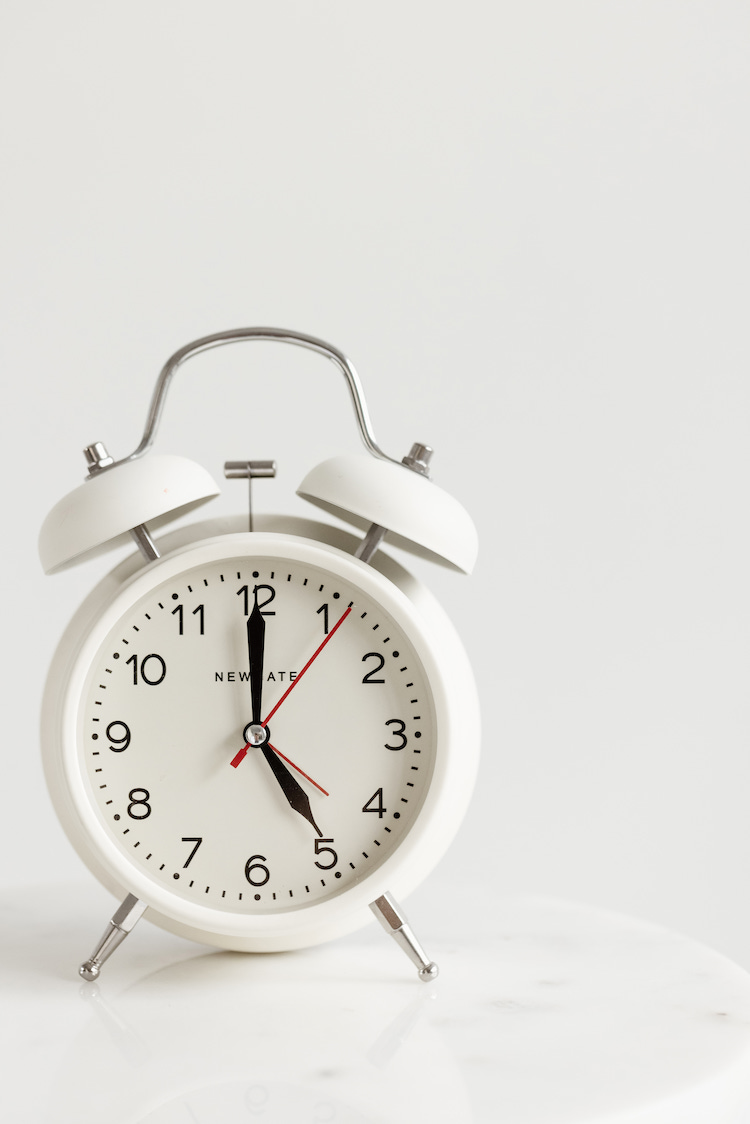
As March kicks off and we eagerly await the official beginning of spring, the excitement builds for longer days and warmer weather (well, at least here in the Midwest). More patio time, dinner on the grill, playing outside, getting the “wiggles” out before bedtime.
However, for parents, like you and I, this time of year also brings the challenge of daylight saving time. We “spring forward”, moving our clocks ahead one hour. Or, as most people will say, we “lose an hour”. Most people are willing to lose an hour for the gain of extra daylight hours, and while this is exciting, it can have a large impact on sleep, especially our child’s sleep.The main challenges that DST comes with, especially “spring”-ing forward, is that bedtime can shift much later for some children, specifically because it’s hard to fall asleep at 7 PM when the sun is still beaming in, convincing our children it’s time to be up and playing.
How Do You Adjust Your Baby or Toddler/Preschooler Sleep For Daylight Savings Time?
Well, this largely depends on your parenting preference and current routine.
Some things you have probably read in regards to how to adjust for the time change; Go in and wake your child at what would be their normal time and then keep their schedule the same from there or several days before time change even happens, adjust your child’s schedule by 15 minutes each day to prepare..
The reason I don’t recommend either of these, is because maybe you are a procrastinator (like me) and you totally forgot about the time change until Saturday and now haven’t had time to make adjustments. Or maybe, you get blessed with a child that may “sleep in” later on Sunday morning and you don’t want to set an alarm to go get them up to keep their body clock aligned.
If this is all sounding more like your vibe, my suggestion is:
Just adjust to the new time change, AKA “just go with it” and do nothing.
That means, if your child is on a set schedule prior to the time change, and you have the ability to let them sleep a bit later in the morning and go to bed later at bedtime, then this may be your option.


One other thing you should know about me; while I LOVE schedules, as I feel they are so powerful and children thrive on schedules, I am not a firm believer of rigid schedules. For this exact reason. Time change will throw a huge wrench in your plans if you are rigid scheduler. When I talk about “set” or time-based schedules with my clients, I always, repeat always, recommend including a 30-minute “buffer”.
If you are a working parent and don’t have the luxury of letting your child sleep later in the morning, Monday after time change will be a smack in the face for the whole family. Especially since it will take you all more time to fall asleep at your normal bedtime. For this, I recommend a gradual transition for several days, to get your child back to their normal time or “set” schedule.
Start the change on Sunday morning
You will get up Sunday morning and set your clocks to the new time. You will adjust your child’s schedule by 30 minutes later than their prior scheduled time. So, if their normal nap time is 12:30 PM, then you will put them down for nap at 1:00 PM that day. Below is an example of what this looks like.


You will follow this adjusted schedule for four days following DST (Sunday-Wednesday). On Thursday, you will return to the previous time schedule.
What if my baby is not on a “schedule”?
This is the easiest transition of all! Just continue using the wake times/wake windows as you currently are! This may mean your baby will be going to sleep later than normal a few days after the time change but with time, they will adjust back towards a similar bedtime.
How long does it take to adjust to daylight savings time?
I usually see that most babies, toddlers, and older children adjust in the first week after time change.
Does daylight saving time affect older children’s sleep?
Absolutely. Just like you, it will take older children some time to adjust to falling asleep at their normal bed time. You will notice that the first week after time change, they may toss and turn in their bed a lot longer and just generally have more trouble falling asleep. Again, that’s because with longer daylight hours, it feels earlier to them and their body clock isn’t ready for sleep quite yet. With patience and time, they will adjust
Other helpful tips for Daylight Saving Time:
- Light Exposure. This shouldn’t be hard, especially since the whole point around DST is that there are more daylight hours available. Getting outside each day and natural light exposure helps produce melatonin and burn off your child’s energy, allowing them to fall into sleep a bit easier. With the excitement of warm weather and longer days, it can be tempting to play outside until 8 PM, I suggest still coming inside at a reasonable evening hour to allow your child some time to decompress and relax going into the bedtime routine.
- Keep routine. Just because the sun is beaming inside the window, doesn’t mean you skip the bedtime routine. Keep each step of your bedtime routine just as you have every night before
- Blackout window coverings. Even if you haven’t been a user or believer of blackout window coverings before, now is the time I recommend using them. While blackout curtains look nice, they still allow a lot of light to filter in around the window, and if you are already fighting a child to go to bed when it’s still light out, blackout window coverings will be your friend. I have several recommendations that vary in quality and price but my two favorites are: BlackoutEZ and Sleepout
- Patience. Just like you and I will struggle falling asleep at bedtime for several nights after the change and won’t want to wake in the morning (hello morning darkness), your child will feel the same way. With patience and time to adjust (see recommendation above), they will get back to their normal routine! However, If it’s been weeks since the time change and things are still challenging around sleep in your home, let’s chat about what could be the culprit!
